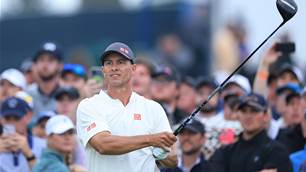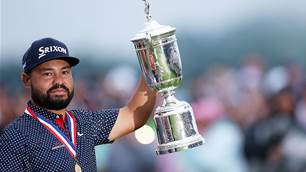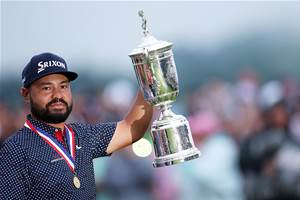Once a year in their U.S Open, the United States Golf Association attempts to find the greatest exponent of driving straight, hacking out from long grass for luck and making knee-trembling pars. Their tourney. Their style. Viva la difference. But it makes for a limited and overly-penal style of golf, even if it is the intention, and even if it produced a wild and compelling Sunday, opines Matt Cleary.
The U.S Open has been run and won, and, as is the way of these things, it was won by pars and "good" bogies, and iced by a long-bomb bird for the ages.
Victor JJ Spaun, the only man under-par after 72 holes of carnage, was best in show at: driving straight on the 25-metre-wide fairways; limiting three-putts on the high-stimp, big-sloping greens; and chopping out best for luck from the thick and tangled mix of ryegrass and poa and old Kentucky blue.
He was best at limiting damage, controlling emotion and making knee-trembling pars on bulbous linoleum. He was best at hanging in there. Hanging tough.
And you may be thinking, Well, duh, that's the idea, champion. It's the U.S Open. You have to hit the ball straight and putt like Crenshaw. Stray shots are punished.
And that is true. That is the organisers' intention.
But why so punished? With no route to birdie or even par at all? Haven't they heard of time off for good behaviour?
Fun is not the way of the USGA, of course. But a more interesting course setup would punish wayward drives by making it very hard, though not impossible, to make par from position X, rather than mandating that to err is death – or at least a sideway chop-out from wrist-thick boombah.
You could as well line every fairway with water. Miss fairway, one-shot penalty. There are people who think Oakmont was better when, along with thick rough, it was lined by giant oak trees. What else you want, you sadistic mad bastards? Rivers of lava? Pits full of spikes? Komodo dragons?
It's not my style of golf. I prefer what they cook up at Augusta National, on the rota of the Open Championship, on the Sandbelt, in the desert Badlands of Nevada and Dubai. How Rory takes on hard-and-fast Royal Melbourne, that, friends, will be entertainment.
Hard and fast, baby. Set the ball to rolling. And when they do flay their ball off the fairway – because they will – they are penalised through the shape of the green, the surrounds, the pin position. The penalty is a much more difficult route to par.
But they're not neccessarily dead nor faced with one oxymoronic option – advance it sideways. There are options for shot-making. They can still conjure magic.

The USGA's mandate for U.S Open courses – one assumes to “protect” the sacred construct of "par" from the gym-fit players and their space-age tech - is that if you’re wayward off the tee, you are penalised. There’s no other shot than hack out and take medicine as if force-fed by funnel.
Now, I'm largely okay with that, even if I waver on it. I waver every year. I've wavered from the beginning to the end of this column, particularly with five holes to play when Oakmont tossed up eight players within two shots. How about that for compelling (if sad for our man Adam Scott) viewing as successive players were spat off the ride like kids on that circular slippery thing at Luna Park.
And, ultimately, it's the U.S Open, it's their baby. And if they want to beat up on the world's best players once a year, have at it.
For there is perverse pleasure watching the great players chop it about as we do on a Saturday from the back tees in the medal. How they handle being bad at golf is instructive. We can empathise with these people.
Yet such a setup remains limiting. For it offers little in the way of shot-making, at least outside hitting power-fades into short par-fours. There are no expression sessions in the U.S Open, such as Augusta National can elicit at its Masters Invitational.
While Spaun's drive on the short par-4 17th was spectacular, Oakmont produced no six-iron by Phil Mickelson from the pine straw on 13. No Bubba Watson hooking wedge on 10. No Rory McIlroy on 15 in the last round this year.
Remember that? Of course you remember that. There’s Rory, under the pump, 200-yards out, behind the trees and ripping off The Magnificent; a high and ropey bit of kit that gave him a look at eagle. What about that shot.
What about it? It doesn’t happen at Oakmont, is what about it. Had Rory gone left on 15 at Oakmont, a 480-metre uphill par-4 with a blind drive to a narrow, sloping fairway, he’d either be deep in the boombah or playing for luck from the piano key bunker.

With modern agronomy methods, Oakmont staff are instructed to trim the rough that’s been flattened by spectators and fluff it back up into clutching witch fingers. They have machines purpose-built for it.
It means you’re unlikely to see a charge from a player on a heater, as Johnny Miller was in 1973 at Oakmont, when he won from six shots back with a Sunday 63. More likely that someone gets in the house at two-over or something and waits for the field to bumble on in.
Robert MacIntyre (+1) was that golfer. He was headed only by a man went birdie-birdie to finish.
Does the U.S Open's atrition christen the greatest golfer? Or the one who chops sideways best? Maybe you think that’s the same thing. Maybe you’re right. But it does rather affect these great players' ability to effect the spectacular, to summon the creative gung-ho of the buccaneer.
In the dictionary, see Seve Ballesteros.
In 1980, after winning the Open Championship at Lytham and the Masters at Augusta, the Spaniard came to the U.S Open at Baltusrol but missed his tee-time and was DQ’d.
“It doesn't matter,” he told reporters. “I couldn't win anyway, the rough is too severe.”
It’s a generalisation, and thus holds some water, that buccaneers don’t win the U.S Open, technical automatons do. The USGA’s Perfect Golf Man is Ben Hogan. Steely-eyed, emotion-free, robotic. Hale Irwin hit fairways, won it three times. Brooks Koepka and Dustin Johnson channeled the Terminator.
It doesn’t always work out thus, of course. The tournament does draw out creatives: McIlroy, Tom Watson, bomb-n-gouge Bryson DeChambeau. Fuzzy Zoeller won, Payne Stewart won, Ernie Els won twice. Our own Geoff Ogilvy, a thoughtful man, a creator, won.
And, of course, the legends, Arnold Palmer, Tiger Woods, Jack Nicklaus, go back to Bobby Jones, they won and won well. And made pars by hitting it straight and putting dots off. And they were worthy champions all.
But this one at Oakmont felt like too much of a lottery. It was too much carnage, too little light. Certainly no fun. And the shot-making of so many major champions was rendered moot.
Yes, yes, a thousand times yes, man, have you read nothing, a sterling effort from JJ Spaun who best tamed the beast. And, once a year, if it is their wont, and it is, the USGA can flay the world's best players like horse thieves. I like the 280m par-3.
But as Miller said on Saturday: “You’ve got to hit fairways … that’s why Bryson’s watching on television this weekend.”
Related Articles

100 not out: Scott's consolation after US Open crash

Spaun drains monster putt for unlikely US Open triumph















